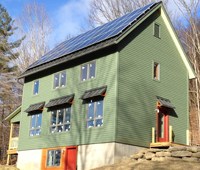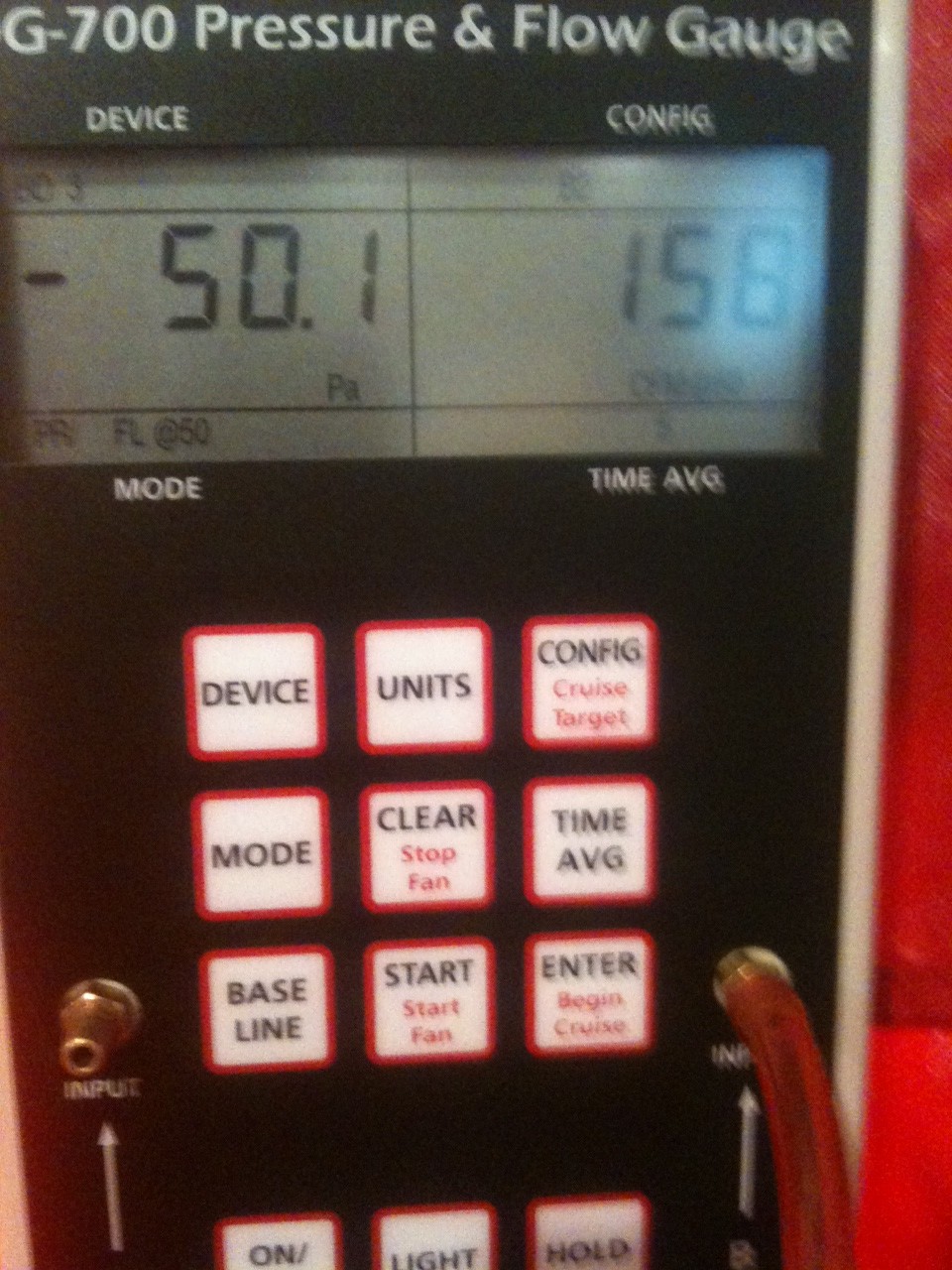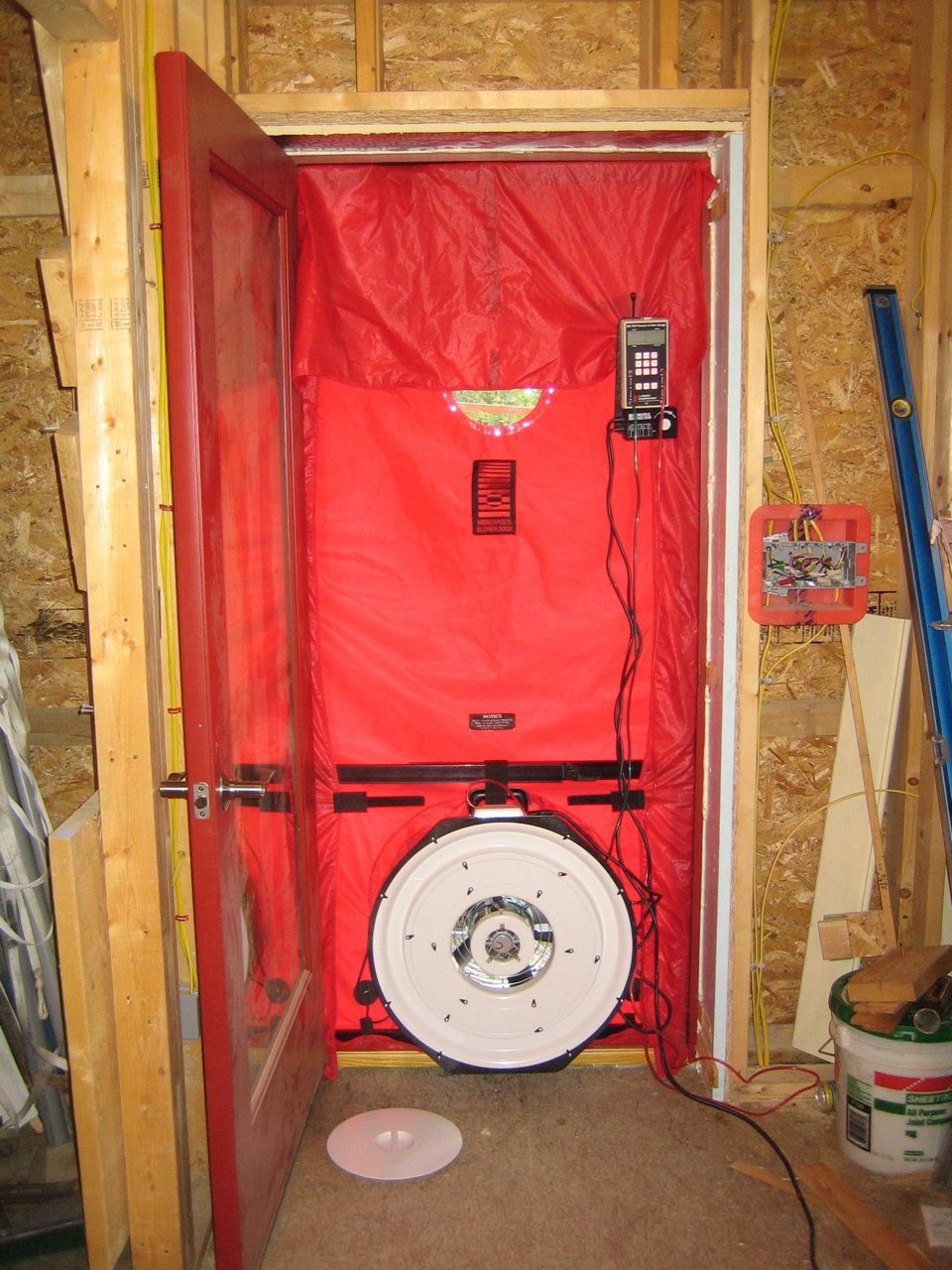Shell blower door test results
Today was the big day. Matthew Evans from Newport Ventures came out to the house to conduct our first blower door test, and the results were very encouraging. Our final reading was 159 CFM or 0.56 ACH.
This was the first of two blower door tests. This first test is used to determine the air tightness of the house enclosure or shell. All plumbing vents and air ducts are blocked for this test. Doing this test before the house is fully insulated makes it easier to find and fix any leaks. The second test is conducted after the house is finished and is considered the official number.
For this first test we were shooting for 200 to 300 CFM (see earlier posts, How tight is tight enough? and The cost of infiltration). Our initial testing over the weekend using a blower door our insulation installer loaned us gave us a reading in the 250 to 300 CFM range. This was helpful because it allowed us to pinpoint a few areas in the shell that we had missed, the connection of the ERV ducts to the exterior and a few other plumbing and electrical penetrations.
The initial reading from Matthew today was 185 CFM. In order to convert that value to air changes per hour (ACH) you multiply the CFM times 60 and divide by the volume of the house. He had calculated the volume of the house as 16,896 ft3 (32’ * 22’ * 24’). The resulting ACH is 0.66. If you use the PassivHaus definition of volume (at least the best I can understand) then the volume would be 13,697 ft3 and the ACH, 0.81. So we’re very close to one of the tightest standards for residential homes.
But there’s more.
We had covered all the plumbing vents and air ducts with plastic and tape, but Matthew found a few holes in our tape and lose plastic fittings. So he plugged the two exterior vents and we re-ran the test. The new blower door reading was 159 CFM or 0.56 ACH. (159 CFM was the average over 10 seconds. At the moment I took the photo above it was registering 158 CFM.) By PassivHaus volume standards this would be 0.7 ACH.
To put it mildly, this was better than we could have imagined.
But there’s no time to celebrate, we’re on a schedule. Tomorrow our insulator is coming back to blow more cellulose on the 2nd floor and in the attic, and we have siding to finish and more sheetrock to hang. Not to mention getting our gutter supplier to ship our order. I’m not having a good customer experience at guttersupply.com.

Categories
- Air sealing 13
- Appliances & Fixtures 4
- Art 3
- Award 4
- Bathroom 8
- Batteries 1
- Decor 5
- Design 10
- Electrical 5
- Energy Calculations 13
- Energy Monitors 4
- Farm 1
- Finance 1
- Flooring 3
- Foundation 9
- Framing 8
- Heating 9
- House 7
- Insulation 8
- Kitchen 6
- Landscaping 3
- Lessons Learned 1
- Performance 60
- Plumbing 10
- Porch 5
- Radon 1
- Rainwater catchment 3
- Research / study 1
- Roof 7
- Septic / Waste water 2
- Sheetrock 6
- Siding 9
- Site Work 22
- Smart home 1
- Solar 64
- Solar Obsessed 10
- Stairs 2
- Surveying 3
- Ventilation 8
- Weather 1
- Windows & Doors 14
- plug-in 3
Archive
- Jan 2021 1
- Dec 2020 2
- May 2020 1
- Jan 2020 1
- May 2019 1
- Jan 2019 3
- Sep 2018 2
- Aug 2018 2
- Jan 2018 1
- Oct 2017 2
- Apr 2017 1
- Jan 2017 1
- Oct 2016 2
- Aug 2016 1
- Apr 2016 2
- Jan 2016 2
- Nov 2015 2
- Oct 2015 1
- Jul 2015 1
- May 2015 1
- Apr 2015 1
- Jan 2015 1
- Dec 2014 1
- Nov 2014 2
- Oct 2014 4
- Sep 2014 2
- Aug 2014 1
- Jul 2014 1
- Mar 2014 3
- Feb 2014 2
- Jan 2014 2
- Nov 2013 1
- Oct 2013 1
- Sep 2013 1
- Jul 2013 3
- Apr 2013 3
- Jan 2013 3
- Dec 2012 2
- Nov 2012 3
- Oct 2012 1
- Sep 2012 3
- Aug 2012 3
- Jul 2012 2
- Jun 2012 1
- May 2012 3
- Apr 2012 2
- Mar 2012 4
- Feb 2012 4
- Jan 2012 5
- Dec 2011 4
- Nov 2011 9
- Oct 2011 10
- Sep 2011 9
- Aug 2011 6
- Jul 2011 6
- Jun 2011 12
- May 2011 8
- Apr 2011 4
- Mar 2011 5
- Jan 2011 6
- Dec 2010 9
- Nov 2010 3
- Oct 2010 4
- Sep 2010 6
- Aug 2010 8
- Jul 2010 6
- Jun 2010 3
- May 2010 3
- Apr 2010 1
- Mar 2010 3
- Feb 2010 3
- Dec 2009 1
- Jun 2009 1
- May 2009 1
- Feb 2009 1
- Dec 2008 1
- Nov 2008 1
- Jun 2008 1


